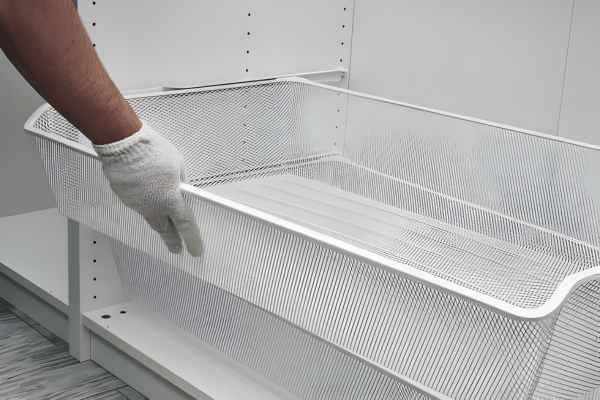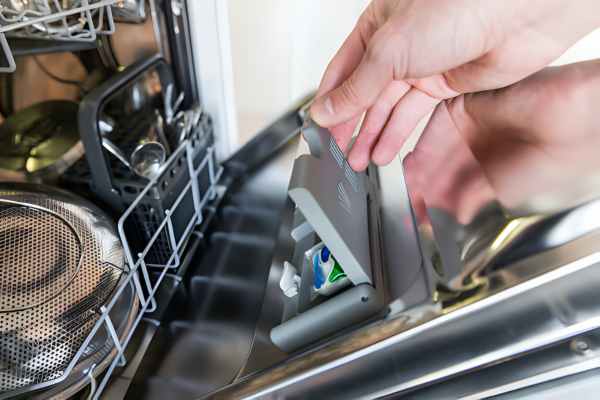Dishwashers are a staple in modern kitchens, offering convenience and efficiency in cleaning dishes. However, to ensure optimal performance, regular maintenance is essential. One crucial yet often overlooked aspect of dishwasher care is the proper cleaning and maintenance of the dishwasher filter. Over time, food particles, soap scum, and debris can accumulate in the filter, leading to subpar cleaning results and potential damage to the appliance. In this blog post, we will delve into the step-by-step process of how to remove and clean your dishwasher filter. Whether you’re dealing with persistent food residue on your plates or noticing a stagnant odor emanating from your dishwasher, understanding how to effectively address and maintain the filter can make a significant difference in your appliance’s performance.
How do you remove a dishwasher door filter?
To remove a dishwasher door filter, first, open the dishwasher door and locate the filter at the bottom of the dishwasher door. The filter is usually a small, removable piece that can be pulled out or twisted to unlock it from its position. Once you have located the filter, gently pull or twist it to release it from its housing. Be careful not to force it too hard, as you don’t want to damage the filter or the surrounding components.
After removing the filter, inspect it for any debris or residue that may have accumulated. Use a soft brush or cloth to clean off any buildup, and then rinse the filter under running water to ensure it’s thoroughly clean. Once cleaned, simply place the filter back into its housing and lock it into position by twisting or pushing it back in place. It’s important to regularly clean your dishwasher filters to maintain optimal performance and prevent clogs or blockages in your dishwasher system.
How do You remove the filter from the bottom of my Whirlpool dishwasher?
To remove the filter from the bottom of your Whirlpool dishwasher, start by locating the filter cover at the bottom of the dishwasher. Depending on the model, you may need to unscrew or unlatch the cover to access the filter. Once the cover is removed, carefully lift out the filter assembly, taking note of how it is positioned for reassembly later.
Gently clean any debris or food particles from the filter using a soft brush or sponge. You can also rinse it under running water to ensure it’s thoroughly clean. After cleaning, carefully place the filter back into its original position and secure the cover back in place. This simple maintenance step will help keep your dishwasher running efficiently and prevent clogs in the drainage system.
Factor to Consider How To Remove Dishwasher Filter
Model-Specific Instructions
Different dishwasher models have varying designs for their filters. Before attempting to remove the filter, check the user manual for your specific model to understand the correct procedure. This helps avoid any damage to the filter or dishwasher.
Safety Precautions
Always turn off and unplug the dishwasher before attempting to remove the filter. This eliminates the risk of electrical shock and ensures your safety.
Condition of the Filter
Be aware of the filter’s condition. If it’s been a while since the last cleaning, it might be heavily caked with debris, requiring more careful handling and possibly soaking before removal.
Tools and Cleaning Supplies
Consider what tools or cleaning supplies you might need. Some filters can be removed by hand, while others might require a tool. Also, think about what you’ll use to clean the filter once it’s removed, such as a soft brush or specific cleaning agents.
Reassembly and Maintenance
Understand how to properly reassemble the filter after cleaning. Incorrect reassembly can lead to poor dishwasher performance or even damage. Also, consider the regular maintenance schedule for the filter to ensure your dishwasher operates efficiently.
Here Are Some Ideas How To Remove Dishwasher Filter
Turn Off Power

Before diving into the task of removing the dishwasher filter, take a moment to locate the power source and switch it off. This may involve turning off the circuit breaker or unplugging the unit altogether. By doing so, you’ll create a safer environment for yourself as you proceed with maintaining your dishwasher. Remember, when working with any electrical appliance, taking precautions such as turning off the power should always be a top priority. Turning off the power also serves as a critical reminder that our modern conveniences come with potential hazards if not handled with care.
Remove Bottom Rack

Removing the bottom rack is a crucial step in accessing and cleaning the dishwasher filter. Many people assume that the bottom rack removal process is straightforward, but there are some important tips to remember to ensure you do it correctly. Start by pulling the bottom rack out until it reaches its full extension, then lift it slightly and continue pulling until it comes completely out of the dishwasher. Take note of any obstructions or debris that may be hindering the smooth removal of the rack, as these can impact its performance.
Once you have successfully removed the bottom rack, carefully inspect and clean the dishwasher filter to ensure optimal filtration and drainage capabilities. Gently remove any accumulated food particles or residue from both the filter and trap, using a soft brush if necessary. By taking this extra step in your regular maintenance routine, you can prevent potential clogs and keep your dishwasher operating at its best for years to come. Remember that proper care not only extends your appliance’s lifespan but also results in cleaner dishes with every wash cycle.
Locate the Filter

Finding and cleaning the filter is crucial for keeping your dishes sparkling clean. The filter is usually located at the bottom of the dishwasher and is responsible for catching food particles and debris during the wash cycle. To locate the filter, simply remove the bottom rack of the dishwasher and look for a circular or rectangular-shaped cover near the back or center.
Once you’ve located the filter, removing it is typically a matter of twisting or pulling to release it from its housing. Some filters may have tabs that need to be pressed in order to release them. After removing the filter, check for any trapped food particles or debris and give it a thorough rinse under running water to ensure proper cleaning.
Twist to Unlock

The twist-to-unlock mechanism may seem like a simple concept, but it holds the power to unlock more than just doors. This clever design can also be found in the world of kitchen appliances, offering a twist on traditional methods of access. Imagine those quiet moments when you realize that removing a dishwasher filter is no longer an arduous task but rather just a simple twist away.
The twist-to-unlock concept brings an element of creativity and ease to mundane tasks, enhancing everyday experiences with its effortless functionality. With just a slight twist, the once daunting chore of removing a dishwasher filter becomes an easy endeavor. No longer confined to the realms of door locks and containers, this innovation expands our understanding of how basic movements can revolutionize even the most routine activities within our households.
Lift the Filter Out

Lifting the filter out of your dishwasher may seem like a mundane task, but it represents the opportunity to care for your appliance and maintain its optimal performance. The process of removing the dishwasher filter can be likened to peering beneath the surface to uncover hidden secrets; by doing so, you gain a deeper understanding of how your machine operates. In fact, taking this step can make all the difference in terms of ensuring that your dishes come out sparkling clean.
Furthermore, beyond the practical implications, lifting out the filter could serve as a metaphor for self-reflection and inner cleansing. Just as we need to periodically clear our minds from clutter and negativity, our dishwashers require regular maintenance to function effectively.
Check for Additional Parts

maintaining your dishwasher, checking for additional parts is essential for ensuring its optimal performance. One often overlooked component is the dishwasher filter, a crucial element in keeping your dishes clean and your machine running smoothly. Many people are unaware of this part or neglect to clean it regularly, leading to poor washing results and potential damage to the appliance.
To remove the dishwasher filter, start by consulting your user manual for specific instructions tailored to your machine. Generally, you will need to locate the filter at the bottom of the appliance and carefully remove any screws or locking mechanisms before taking it out. Once removed, inspect the filter for debris like food particles or mineral buildup and give it a thorough cleaning.
Clean the Filter Area

Cleaning the filter area of your dishwasher is a crucial yet often overlooked task. Over time, the filter can become clogged with food particles and debris, leading to poor dishwasher performance and even foul odors. To remove the dishwasher filter, start by consulting your appliance’s manual for specific instructions. Most filters can be easily removed by unlocking or twisting them, allowing you to access the debris trapped inside.
Once the filter is removed, rinse it thoroughly under running water to dislodge any stubborn particles. For a deeper clean, soak the filter in a solution of warm water and vinegar to dissolve grease and grime. Additionally, using a soft brush can help scrub away any residue clinging to the filter mesh. By keeping the filter area clean and well-maintained, you can ensure that your dishwasher runs efficiently and effectively with every use.
Rinse the Filter

Rinsing the filter is a crucial yet often overlook step in maintaining a clean and efficient dishwasher. Many people neglect this simple task, unaware of the impact it can have on their appliance’s performance. By regularly rinsing the filter, you can prevent food particles from clogging the drain and ensure your dishes come out sparkling clean.
To remove the dishwasher filter, first consult your appliance’s manual for specific instructions. Generally, it involves unscrewing or lifting out the filter located at the bottom of the machine. Once removed, simply rinse it under running water to dislodge any trapped debris. This quick and easy process can significantly prolong your dishwasher’s lifespan and save you from costly repairs down the line.
Dry the Filter

Dry the filter thoroughly before putting it back into your dishwasher. This is crucial for preventing mold and bacteria growth, as moisture can become trapped in the filter if not properly dried. To ensure thorough drying, leave the filter out to air dry completely for at least 24 hours. You can also use a clean dish towel to pat it dry and remove any remaining moisture.
Another effective method for drying the dishwasher filter is to use compressed air or a hairdryer on a low setting to blow out any lingering water droplets. This will help expedite the drying process and eliminate any hidden moisture within the filter’s crevices. By taking these extra steps to ensure that your dishwasher filter is completely dry before reinserting it, you will contribute to maintaining a cleaner and more sanitary environment inside your appliance.
The Final Thought
Understanding how to remove and clean a dishwasher filter is a crucial aspect of maintaining the efficiency and longevity of your appliance. By taking the time to perform regular maintenance on your dishwasher filter, you can prevent clogs, ensure thorough cleaning, and extend the lifespan of your machine. With the simple steps outlined in this article, you can confidently tackle this task and keep your dishwasher running smoothly. Remember, regular maintenance is key to avoiding costly repairs and replacements down the line.
